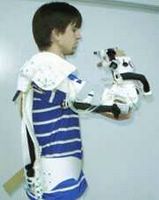Robotic Augmentation Helps Stroke Survivors
Robotic Arm Could Help Stroke Survivors Regain Range of Motion
RLINGTON, Va., April 25, 2005 -- A robotic arm that can be worn at home is being developed to help stroke survivors regain the ability to reach and grasp objects and perform basic tasks such as feed themselves.
The device, built by a research team, led by biomedical engineer Jiping He, Ph.D., and his colleagues at Arizona State University and Kinetic Muscles, Inc., a start up biotech company, can also assess the effectiveness of the physical therapy so adjustments can be made to the regimen if necessary. He will present a paper on the robotic arm this summer at the 9th International Conference on Rehabilitation Robotics in Chicago.

Ruppert
"This device is intended to provide cost-effective therapy to a wider population for a longer period of time for maximum recovery of motor function," He said of the device, dubbed RUPERT I, for Robotic Upper Extremity Repetitive Therapy.
RUPERT I is powered by four pneumatic muscles and is movable at the shoulder, elbow and wrist. The design was based on a kinematics model of the arm, which showed where to locate the pneumatic muscles and how much force was needed for normal reaching and feeding movements. The mechanical arm is adjustable to accommodate different arm lengths and body sizes.
The Whitaker Foundation: Robotic Therapy Device for Stroke Recovery
RLINGTON, Va., April 25, 2005 -- A robotic arm that can be worn at home is being developed to help stroke survivors regain the ability to reach and grasp objects and perform basic tasks such as feed themselves.
The device, built by a research team, led by biomedical engineer Jiping He, Ph.D., and his colleagues at Arizona State University and Kinetic Muscles, Inc., a start up biotech company, can also assess the effectiveness of the physical therapy so adjustments can be made to the regimen if necessary. He will present a paper on the robotic arm this summer at the 9th International Conference on Rehabilitation Robotics in Chicago.

Ruppert
"This device is intended to provide cost-effective therapy to a wider population for a longer period of time for maximum recovery of motor function," He said of the device, dubbed RUPERT I, for Robotic Upper Extremity Repetitive Therapy.
RUPERT I is powered by four pneumatic muscles and is movable at the shoulder, elbow and wrist. The design was based on a kinematics model of the arm, which showed where to locate the pneumatic muscles and how much force was needed for normal reaching and feeding movements. The mechanical arm is adjustable to accommodate different arm lengths and body sizes.
The Whitaker Foundation: Robotic Therapy Device for Stroke Recovery

0 Comments:
Post a Comment
Subscribe to Post Comments [Atom]
<< Home